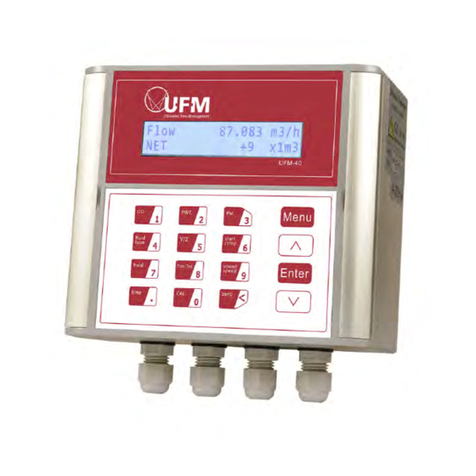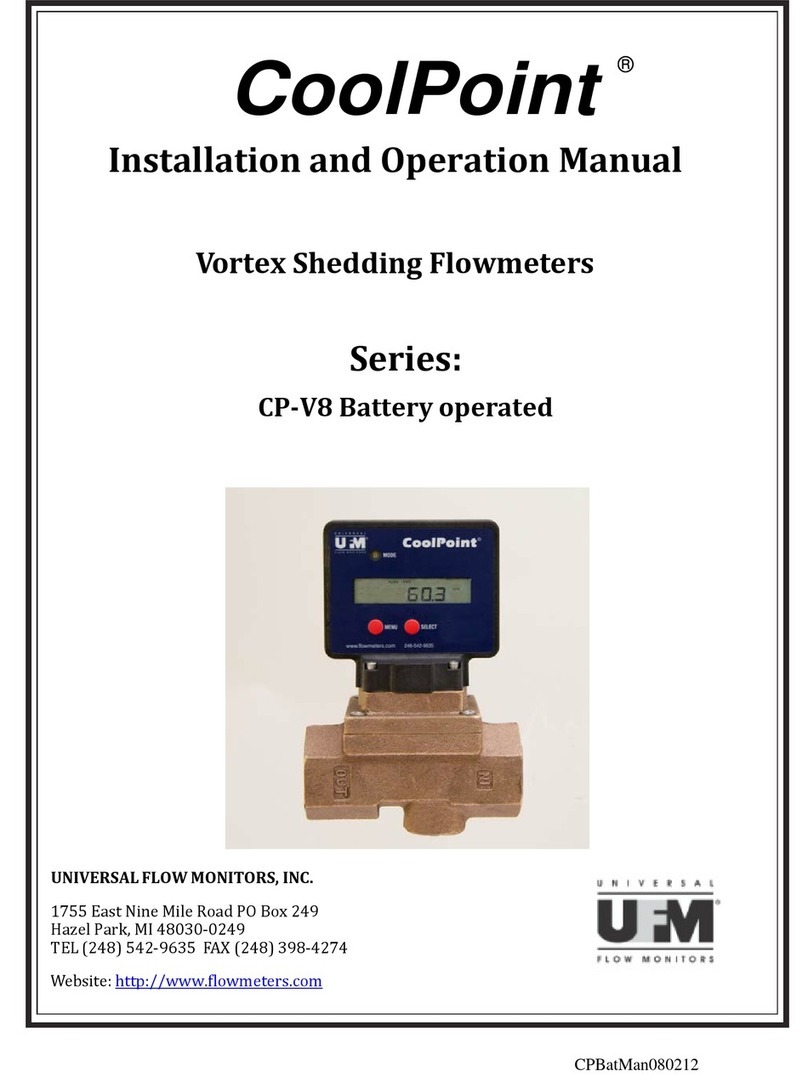TABLE OF CONTENTS
1 SAFETY INSTRUCTIONS, LEGAL REQUIREMENTS,
WARRANTY, RETURN POLICY 4
1.1 Symbols 4
1.2 Safety instructions 4
1.3 Warranty 5
1.4 Return policy 5
1.5 Legislative requirements 5
2 INTRODUCTION 6
2.1 Clamp-on transit-time flowmeter 6
2.2 Measuring principle 6
3 INSTALLATION 7
3.1 Unpacking and storage 7
3.1.1 Unpacking 7
3.1.2 Storage 7
3.1.3 Identification of components 8
3.2 Clamp-on sensor installation 9
3.2.1 Acoustic propagation 9
3.2.2 Straight pipe lengths 9
3.3 Installation location 1
3.4 Pipe preparation 12
3.5 Sensor mounting configurations
and separation distance 13
3.5.1 Reflection Mode 13
3.5.2 Diagonal Mode 13
3.5.3 Transducer separation distance 13
3.6 Flowmeter installation 14
3.6.1 Outline dimensions 14
3.6.2 Electrical connections 15
3.7 Clamp-on sensor mounting 15
3.7.1 Acoustic coupling gel 16
3.7.2 Correct positioning of the sensors 16
3.7.3 Sensor mounting with fixtures
and chains 17
4 OPERATION 18
4.1 Switching On/O 18
4.2 Battery charging 18
4.3 Keypad and display 19
4.3.1 Keypad key functions 19
4.3.2 Display icons and functions 21
4.4 Quick Setup Wizard 22
4.5 Measurement 25
4.5.1 Main process value display 25
4.5.2 Three-line display 25
4.5.3 Diagnostic display 25
4.5.4 Totaliser 26
4.5.5 Data logger 26
5 COMMISSIONING 27
5.1 Menu structure 27
5.2 Output configuration 35
5.2.1 Serial interface 36
5.2.2 Modbus RTU 36
5.2.3 HART® compatible output 37
5.2.4 Analogue current output /4 ... 2 mA 37
5.2.5 Analogue voltage output ... 1 V 38
5.2.6 Analogue frequency output (passive) 38
5.2.7 Digital open-collector output 38
5.2.8 Digital relay output 39
5.3 Input configuration 4
5.3.1 Pt 1 inputs 4
5.3.2 Analogue current input /4 ... 2 mA 4
5.4 Temperature compensation 41
5.5 Heat quantity measurement 41
5.6 Sound velocity measurement 41
5.7 Wall thickness measurement 41
5.7.1 Wall Thickness Gauge Wizard 42
5.8 Scope function 42
5.9 KATdata+ soware 42
6 MAINTENANCE 43
6.1 Service/Repair 43
7 TROUBLESHOOTING 44
7.1 Measurement diiculties and error messages 44
7.2 Data download diiculties 46
8 TECHNICAL DATA 47
8.1 Sound speed of selected pipe materials 47
8.2 Technical data of selected fluids 48
8.3 Dependence between temperature
and sound speed in water 51
9 SPECIFICATION 54
9.1 General 54
9.2 Flowmeter 54
9.3 Quantity and units of measurement 55
9.4 Internal data logger 55
9.5 Communication 55
9.6 KATdata+ soware 55
9.7 Process inputs 56
9.8 Process outputs 56
9.9 Clamp-on sensor: K1N 57
1 INDEX 58
11 APPENDIX A – Certificate of Conformity 59
12 APPENDIX B – Customer Return Note (CRN) 6
Operating Instructions KATflow 21 3/6































